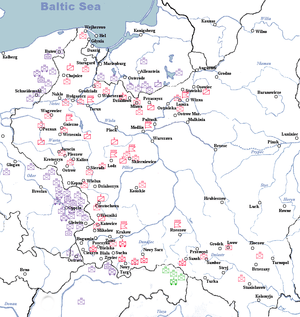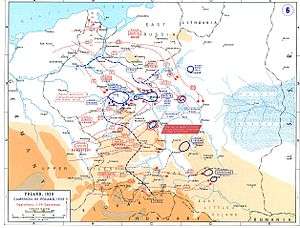Battle of the Border


| ||||||


The Battle of the Border (Polish: Bitwa graniczna) refers to the battles that occurred in the first days[1] of the German invasion of Poland in September, 1939. The series of battles ended in a German victory, as Polish forces were either destroyed or forced to retreat.
Before the battle
The Polish defense plan (Plan Zachód) called for a defense of Poland's borders in case of invasion from Germany. Much of Poland's new industry and major population centers were located in the border area (particularly in Silesia); however, the lengthy border was very difficult to defend properly. The plan was criticized by some of the Polish military and Western advisors, but supported by politicians who feared the effect of abandoning a significant part of the population to the enemy without a fight, and who were further discouraged from abandoning those territories as the Polish allies (France and the United Kingdom) did not guarantee the Borders of Poland and might well decide to allow the Germans to take the Polish Corridor they demanded in exchange for peace (pursuing a policy of appeasement).
The German invasion plan (Fall Weiss) called for the start of hostilities before the declaration of war and for the Blitzkrieg doctrine of lightning war to be pursued. German units were to invade Poland from three directions:
- from the German mainland through the western Polish border
- from the north, from the exclave of East Prussia
- from the territory of Slovakia, accompanied by allied Slovak units
All three assaults were to converge on Warsaw, while the main Polish army was to be encircled and destroyed west of the Vistula.
Poland, which already had a smaller population and thus a smaller military budget and army than Germany, was further disadvantaged because Poland was unsure whether the war would start already, and its armed forces were not fully mobilized by 1 September.
The battle
At 08:00 hours, 1 September, German troops, still without a formal declaration of war issued, attacked near the Polish town of Mokra; the battle of the border had begun. Later that day, the Germans opened fronts along Poland's western, southern and northern borders, while German aircraft began raids on Polish cities. The main routes of attack led eastwards from Germany proper through the western Polish border. A second route carried supporting attacks from East Prussia in the north, and a co-operative German-Slovak tertiary attack by units (Field Army Bernolák) from the territory of the German-allied Slovakia in the south. All three assaults converged on the Polish capital of Warsaw.
In the northwest, the German Army Group North under Fedor von Bock attacked Pomerania and Greater Poland, moving from the Western Germany proper (German Fourth Army) and from East Prussia (German Third Army). In the Battle of Tuchola Forest that lasted from 1 to 5 September they split the Polish Army Pomorze under Władysław Bortnowski which was tasked with the defence of the Polish Corridor; parts of it under admiral Józef Unrug would continue to defend pockets of the coast over the next few days or weeks (at the Battles of Westerplatte, Gdynia, Hel and others) while the rest was forced, together the Army Poznań under Tadeusz Kutrzeba, to retreat east from their defensive lines in Greater Poland towards Kłodawa in Kujawy.
In northern Poland (Masovia), by 3 September part of German Third Army had defeated the Polish Army Modlin under Emil Krukowicz-Przedrzymirski at the battle of Mława; Polish forces retreated towards their secondary lines of defence at the Vistula and Narew rivers, allowing the Germans to move towards their main objective, the Polish capital of Warsaw.
In the south and southwest, the German Army Group South under Gerd von Rundstedt struck along the lines dividing the Polish Army Łódź (under Juliusz Rómmel) from Army Poznań (north) and Army Kraków (south, under Antoni Szylling). Despite several Polish tactical victories (like in the battle of Mokra on 1 September), Polish forces were soon forced to retreat, as Army Łódź was being outflanked by the German Eighth Army and the German Tenth Army. Army Kraków was retreating from Silesia and in the south Army Karpaty under Kazimierz Fabrycy was being slowly pushed north towards the Dunajec and Nida Rivers by the German Fourteenth Army.
By 6 September Polish forces were in retreat and Marshal of Poland Edward Rydz-Śmigły ordered all the troops to fall back to the secondary lines of defences at the Vistula and San Rivers.
Aftermath
Virtually all battles that are considered part of the 'Battle of the Border' (with the exception of the Battle of Hel, which lasted for more than a month and the Battle of Mokra, a Polish defensive victory) resulted in rapid defeat of Polish forces, which were forced to abandon the regions of Pomerania, Greater Poland and Silesia. Those defeats in turn made it more difficult for the Polish forces to fall back in an organized way to the secondary lines of defence (behind the Vistula and near the Romanian bridgehead).
Battles of the border
The Battle of the Border included the following battles:[1]
- That ended before or on September 3:
- Defense of the Polish Post Office in Danzig - 1 September
- Battle of Chojnice- 1 September
- Skirmish of Krojanty - 1 September
- Battle of Lasy Królewskie - 1 September
- Battle of Mokra - 1 September
- Battle of Pszczyna - 1 to 4 September
- Battle of Grudziądz - 1 to 3 September
- Battle of Mława and Ciechanow - 1 to 4 September
- Battle of Jordanów - 2 September
- Raid on Fraustadt - 2 September
- Battle of Węgierska Górka - 1 to 3 September
- That began before September 3 and ended before or on September 7:
- Battle of Tuchola Forest - 1 to 5 September
- Battle of Borowa Góra - 2 to 5 September
- Battle of Westerplatte - 1 to 7 September
- That began after September 3 and ended before or on September 7:
- Battle of Różan - 4 to 6 September
- Battle of Piotrków Trybunalski - 5 to 6 September
- Battle of Tomaszów Mazowiecki - 6 September
- That began before September 7 and lasted afterwards:
- Battle of Wizna - 6 to 10 September
- Battle of Hel - 1 September to 2 October
See also
- German order of battle for Operation Fall Weiss
- Opposing forces in the Polish September Campaign
- Polish army order of battle in 1939
Notes
- 1 2 The Battle of the Border began on 1 September, but sources vary with their assignment of an end date for this phase of the campaign. The shortest period is delimited by the date of 3 September (Encyklopedia Internautica), usually related to the Battle of Mława, while the longer one gives the date of the 6th (Encyklopedia PWN) (the order of Edward Rydz-Śmigły to fall back) or sometimes the 7th of September (the symbolic capitulation of Westerplatte).
References
- (Polish) Kampania Wrześniowa (September Campaign), section on the Battle of the Border